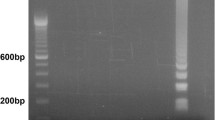Abstract
Enteroviruses are found in most environments and cause several diseases in humans. Loop-mediated isothermal amplification (LAMP) was adapted and evaluated for the rapid detection of enteroviruses. Based on the highly conserved 5′ untranslated region (5′-UTR) of the human enteroviruses (HEVs), particularly human enterovirus A (HEV-A) and HEV-B, a set of universal primers was designed. The LAMP amplification was carried out under isothermal conditions at 61 °C, depending on the template concentration results were obtained within 45–90 min. The detection limits were found to be 101 copies of cloned enterovirus 71 fragments, more sensitive than conventional PCR. Nine water samples collected from drinking water sources during three seasons and 19 stool specimens collected from HFMD patients were analyzed. By using the LAMP assay, the majority of samples was tested positive, 9/9 (100 %) and 18/19 (94.7 %), respectively. LAMP is a practical method for the rapid detection of enteroviruses in environmental and clinical samples.





Similar content being viewed by others
References
Khetsuriani N, LaMonte-Fowlkes A, Oberste MS, Pallansch MA (2006) Enterovirus surveillance-United States, 1970-2005. MMWR Surveill Summ 55:1–20
Kargar M, Sadeghipour S, Nategh R (2009) Environmental surveillance of non-polio enteroviruses in Iran. Virol J 6:149
Pallansch MA, Roos RP (2001) Enteroviruses: polioviruses, coxsackieviruses, echoviruses, and newer enteroviruses. In: Knipe DM, Howley PM (eds) Fields virology, 4th edn. Lippincott Williams and Wilkins Press, Philadelphia, pp 723–775
Rajtar B, Majek M, Polański Ł, Polz-Dacewicz M (2008) Enteroviruses in water environment-a potential threat to public health. Ann Agric Environ Med 15:199–203
Lee HK, Jeong YS (2004) Comparison of total culturable virus assay and multiplex integrated cell culture-PCR for reliability of waterborne virus detection. Appl Environ Microbiol 70:3632–3636
Hymas WC, Aldous WK, Taggart EW, Stevenson JB, Hillyard DR (2008) Description and validation of a novel real-time RT-PCR enterovirus assay. Clin Chem 54:406–413
Hu X, Zhang Y, Zhou X, Xu B, Yang M, Wang M, Zhang C, Li J, Bai R, Xu W, Ma X (2012) Simultaneously typing nine serotypes of enteroviruses associated with hand, foot, and mouth disease by a GeXP analyzer-based multiplex reverse transcription-PCR assay. J Clin Microbiol 50:288–293
Pusch D, Ihle S, Lebuhn M, Graeber I, Lopez-Pila JM (2005) Quantitative detection of enteroviruses in activated sludge by cell culture and real-time RT-PCR using paramagnetic capturing. J Water Health 3:313–324
Notomi T, Okayama H, Masubuchi H, Yonekawa T, Watanabe K, Amino N, Hase T (2000) Loop-mediated isothermal amplification of DNA. Nucleic Acids Res 28:e63
Angamuthu R, Baskaran S, Gopal DR, Devarajan J, Kathaperumal K (2012) Rapid detection of the Marek’s disease viral genome in chicken feathers by loop-mediated isothermal amplification. J Clin Microbiol 50:961–965
Yaqing H, Wenping Z, Zhiyi Y, Xionghu W, Shouyi Y, Hong Y, Yingchun D, Guifang H (2012) Detection of human Enterovirus 71 reverse transcription loop-mediated isothermal amplification (RT-LAMP). Lett Appl Microbiol 54:233–239
Zhou T, Du L, Fan Y, Zhou Y (2012) Reverse transcription loop-mediated isothermal amplification of RNA for sensitive and rapid detection of southern rice black-streaked dwarf virus. J Virol Methods 180:91–95
Hyypiä T, Hovi T, Knowles NJ, Stanway G (1997) Classification of enteroviruses based on molecular and biological properties. J General Virol 78:1–11
Smura T, Blomqvist S, Paananen A, Vuorinen T, Sobotová Z, Bubovica V, Ivanova O, Hovi T, Roivainen M (2007) Enterovirus surveillance reveals proposed new serotypes and provides new insight into enterovirus 5′-untranslated region evolution. J Gen Virol 88:2520–2526
Nwachuku N, Gerba CP (2006) Health risks of enteric viral infections in children. Rev Environ Contam Toxicol 186:1–56
Pöyry T, Kinnunen L, Hyypiä T, Brown B, Horsnell C, Hovi T, Stanway G (1996) Genetic and phylogenetic clustering of enteroviruses. J Gen Virol 77:1699–1717
Siafakas N, Markoulatos P, Stanway G (2002) Molecular classification of coxsackie A viruses on the basis of the 5′-UTR: structural and evolutionary aspects. J Mol Evol 55:638–652
Arita M, Ling H, Yan D, Nishimura Y, Nishimura Y, Yoshida H, Wakita T, Shimizu H (2009) Development of a reverse transcription-loop-mediated isothermal amplification (RT-LAMP) system for a highly sensitive detection of enterovirus in the stool samples of acute flaccid paralysis cases. BMC Infect Dis 9:208
Wang X, Zhu JP, Zhang Q, Xu ZG, Zhang F, Zhao ZH, Zheng WZ, Zheng LS (2012) Detection of enterovirus 71 using reverse transcription loop-mediated isothermal amplification (RT-LAMP). J Virol Methods 179:330–334
Poon LL, Wong BW, Ma EH, Chan KH, Chow LM, Abeyewickreme W, Tangpukdee N, Yuen KY, Guan Y, Looareesuwan S, Peiris JS (2006) Sensitive and inexpensive molecular test for falciparum malaria: detecting Plasmodium falciparum DNA directly from heat-treated blood by loop-mediated isothermal amplification. Clin Chem 52:303–306
Acknowledgments
This study was supported by Tianjin Research Program of Application Foundation and Advanced Technology (No.09JCYBJC08400 and No.10JCZDJC24600).
Author information
Authors and Affiliations
Corresponding author
Electronic supplementary material
Below is the link to the electronic supplementary material.
Rights and permissions
About this article
Cite this article
Zhao, HB., Yin, GY., Zhao, GP. et al. Development of Loop-Mediated Isothermal Amplification (LAMP) for Universal Detection of Enteroviruses. Indian J Microbiol 54, 80–86 (2014). https://doi.org/10.1007/s12088-013-0399-7
Received:
Accepted:
Published:
Issue Date:
DOI: https://doi.org/10.1007/s12088-013-0399-7




